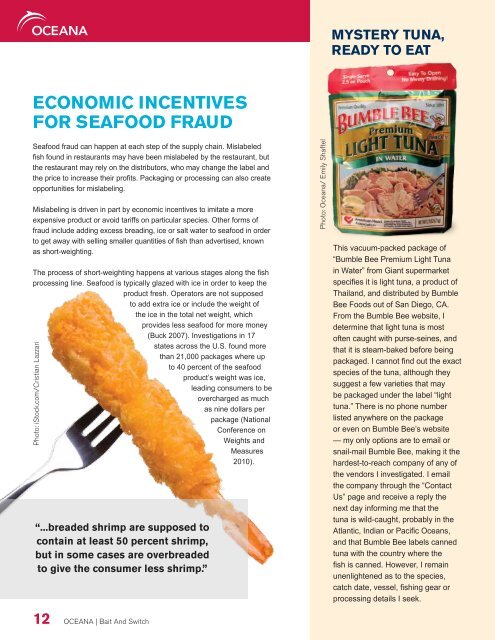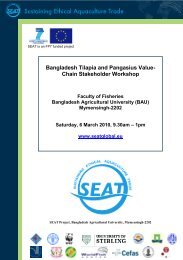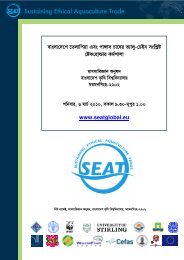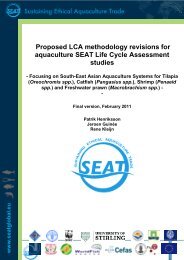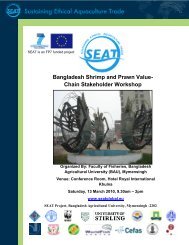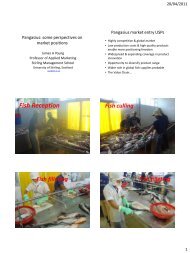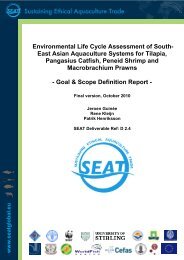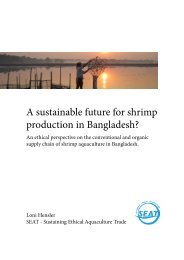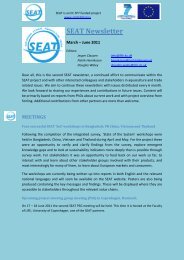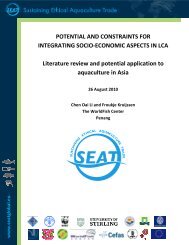Bait and Switch:
Bait and Switch:
Bait and Switch:
Create successful ePaper yourself
Turn your PDF publications into a flip-book with our unique Google optimized e-Paper software.
economic incentiveS<br />
for Seafood fraud<br />
Seafood fraud can happen at each step of the supply chain. Mislabeled<br />
fish found in restaurants may have been mislabeled by the restaurant, but<br />
the restaurant may rely on the distributors, who may change the label <strong>and</strong><br />
the price to increase their profits. Packaging or processing can also create<br />
opportunities for mislabeling.<br />
Mislabeling is driven in part by economic incentives to imitate a more<br />
expensive product or avoid tariffs on particular species. Other forms of<br />
fraud include adding excess breading, ice or salt water to seafood in order<br />
to get away with selling smaller quantities of fish than advertised, known<br />
as short-weighting.<br />
The process of short-weighting happens at various stages along the fish<br />
processing line. Seafood is typically glazed with ice in order to keep the<br />
product fresh. Operators are not supposed<br />
to add extra ice or include the weight of<br />
the ice in the total net weight, which<br />
provides less seafood for more money<br />
(Buck 2007). Investigations in 17<br />
states across the U.S. found more<br />
than 21,000 packages where up<br />
to 40 percent of the seafood<br />
product’s weight was ice,<br />
leading consumers to be<br />
overcharged as much<br />
as nine dollars per<br />
package (National<br />
Conference on<br />
Weights <strong>and</strong><br />
Measures<br />
2010).<br />
Photo: iStock.com/cristian Lazzari<br />
“...breaded shrimp are supposed to<br />
contain at least 50 percent shrimp,<br />
but in some cases are overbreaded<br />
to give the consumer less shrimp.”<br />
12<br />
oceana | <strong>Bait</strong> <strong>and</strong> <strong>Switch</strong><br />
Photo: oceana/ emily Shaftel<br />
myStery tuna,<br />
ready to eat<br />
This vacuum-packed package of<br />
“Bumble Bee Premium Light Tuna<br />
in Water” from Giant supermarket<br />
specifies it is light tuna, a product of<br />
Thail<strong>and</strong>, <strong>and</strong> distributed by Bumble<br />
Bee Foods out of San Diego, CA.<br />
From the Bumble Bee website, I<br />
determine that light tuna is most<br />
often caught with purse-seines, <strong>and</strong><br />
that it is steam-baked before being<br />
packaged. I cannot find out the exact<br />
species of the tuna, although they<br />
suggest a few varieties that may<br />
be packaged under the label “light<br />
tuna.” There is no phone number<br />
listed anywhere on the package<br />
or even on Bumble Bee’s website<br />
— my only options are to email or<br />
snail-mail Bumble Bee, making it the<br />
hardest-to-reach company of any of<br />
the vendors I investigated. I email<br />
the company through the “Contact<br />
Us” page <strong>and</strong> receive a reply the<br />
next day informing me that the<br />
tuna is wild-caught, probably in the<br />
Atlantic, Indian or Pacific Oceans,<br />
<strong>and</strong> that Bumble Bee labels canned<br />
tuna with the country where the<br />
fish is canned. However, I remain<br />
unenlightened as to the species,<br />
catch date, vessel, fishing gear or<br />
processing details I seek.


